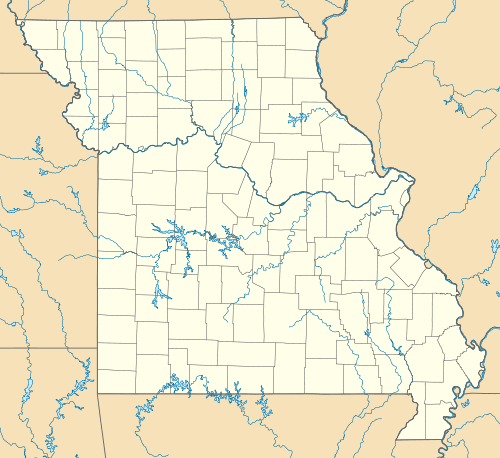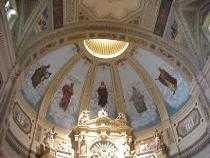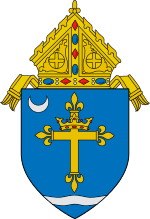Shrine of St. Joseph
|
Shrine of Saint Joseph | |
|
St. Louis Landmark | |
 | |
|
Shrine of St. Joseph St. Louis, Missouri | |
 | |
| Location |
1220 North 11th Street St. Louis, Missouri 63106 |
|---|---|
| Coordinates | 38°38′14.15″N 90°11′33.45″W / 38.6372639°N 90.1926250°WCoordinates: 38°38′14.15″N 90°11′33.45″W / 38.6372639°N 90.1926250°W |
| Architect | Purvis, George |
| Architectural style | Other |
| Governing body | Private |
| NRHP Reference # | 78003396[1] |
| Added to NRHP | 1978 |
The Shrine of St. Joseph is a Catholic church in St. Louis, Missouri in Columbus Square. The church began in 1843 when the Jesuits founded the parish to serve the residential community consisting mostly of German immigrants. The church is the site of the only authenticated miracle in the Midwestern United States.
History
1846–1866
After founding the parish in 1843, the Jesuits immediately instituted to build a church. Mrs. Ann Biddle a wealthy widow, known for her many philanthropic deeds, donated the land for the new church. The cornerstone for the new church was blessed by Bishop Kenrick on April 14, 1844. The completed building was a modest building faced west toward 11th Street was dedicated on the first Sunday in August, 1846 with Father James Van de Velde, later Bishop of Chicago, officiating.
Soon St. Joseph parish was a very active community. In 1862 a large parish school was built nearby, to care for the many children of the area. The School Sisters of Notre Dame staffed the school. In late 1861 a German immigrant, Ignatius Strecker, was suffering from an injury he incurred while working at a local soap factory. Despite being given much treatment Strecker grew worse and worse and was finally told by doctors that he had two weeks to live.
1866–1880
Just at this time a Jesuit missionary, Father Francis Xavier Weninger, came to St. Joseph's to preach. Mrs. Strecker happened to attend the service in which Father Weninger preached on the Blessed Peter Claver, who was held to have great intercessory powers with God. She was so impressed she hurried home to implore her dying husband to seek the help of Peter Claver.
The next day, Wednesday, March 16, 1864, Strecker dragged himself to the church. He arrived just as Father Weninger was blessing the congregation with a relic of Peter Claver. Observing Strecker's extreme weakness, the priest allowed him to kiss the relic. Immediately, the sick man seemed to experience a resurgence of strength. He began to heal and within a few days he returned to his job, and in a few months he was restored to full health.[2]
Two years after this cure, the Most Reverend Michael O'Connor, a Jesuit priest, made a thorough canonical investigation of the incident. In 1887 the miracle was formally declared authentic by Cardinal Bianchi in Rome, and was chosen as one of the two required miracles in the canonization process of Peter Claver, who became a Saint the following year. St. Joseph's became the only church in St. Louis, which is the site of an authenticated miracle and developed a legend of assistance to the afflicted.
As news of the miracle spread, and the parish grew, it became obvious that the original church was no longer large enough to serve the congregation. It was decided to build a large addition to the old building and to revise the structure so that the entrance faced on Biddle Street. Bishop Kenrick laid the cornerstone for this second St. Joseph in 1865.
As work progressed on the remolding of the church cholera broke out in St. Louis in August 1866. St. Joseph's parish alone had as many as 20 burials a day. Cholera was caused by contaminated drinking water and was contagious. The Jesuit Fathers and Brothers of St. Joseph did what they could to help.
At the height of the epidemic, Father Joseph Weber, pastor of St. Joseph gathered the parishioners together. With them they made a solemn vow that if St. Joseph would intercede for them, so that there were no further deaths from cholera in the parish, they would erect a suitable monument to him as a thanksgiving tribute. Then and there the congregation pledged an initial $4,000 for this purpose.
From that day on not a single member of any family who had signed the vow and pledge died of the dread disease. The parish decided that a fitting monument to Saint Joseph to express their gratitude would be a special altar installed for their newly remodeled church.
Bueschers of Chicago, famous for their religious art work, were employed to carve an elaborate altar, which is designed as a replica of the Altar of St. Ignatius in the Jesuit Gesu Church in Rome, except that the figure of St. Joseph and the Christ Child are substituted for the figure of St. Ignatius. Beneath the central figures appear the words: "Ite ad Joseph" Go to Joseph.
Known as "The Altar of Answered Prayers" because of its origin, this beautiful work can still be seen at St. Joseph's Shrine, where it serves as the central altar. It was installed early in 1867, at a total cost of $6,131. The grateful parishioners raised the additional funds above their original pledge in recognition of their deliverance from the cholera epidemic.
The primary remolding was completed in 1866. Father Pierre Jean De Smet, noted missionary to the Indians, officiated at the dedication services on December 30, 1866.
1880–1954
In 1880 the church was once again enlarged and remodeled. This work, which included the addition of an elaborate Romanesque face and twin towers surmounted with delicate cupolas, was completed in 1881.
Further alterations had to be made in 1954, under the supervision of the shrine's pastor, Father Anthony Corey. At this time, for reasons of safety, the beautiful original towers were shortened, and the cupolas replaced by heavier, hexagonal caps, thus considerably altering the exterior of the building, and detracting form its former beauty. This was after the Jesuits left the parish and was staffed by priest of the Archdiocese.
While owned by the Archdiocese of St. Louis the now Shrine of St. Joseph is leased to The Friends of The Shrine of St. Joseph, Inc. a not for profit 503(c)(3) corporation. All donations are tax deductible to the extent allowable by law.
Miracles
St. Peter Claver’s Miracle
Ignatius Strecker came to America from Germany in 1853 and settled with his wife and daughter in St. Joseph’s parish, in St. Louis. He was a temperate, conscientious, and religious man, devoted to his family, which eventually numbered nine children. He was also a hard worker in the soap factory where he found employment.
In this factory, one day towards the end of 1861, Strecker accidentally struck his chest sharply against a pointed piece of iron. His breastbone was injured, though no outward wound was at first visible. Still there was considerable pain, a burning sensation, and some swelling. This busy workman did not pay much attention to his injury until after two months, the tumor-like inflammation began to grow alarmingly; and, there was no way to drain off the accumulating malignant matter. Doctor Joseh Heitzig, the family physician, was called in.
When certain external remedies were tried and failed to cure, Heitzig opened up the wound with an instrument, only to find the breastbone and some ribs on the left side in a state of incipient decomposition. A series of injections failed to clear this up, as did other remedies. The patient only grew worse. Moreover, violent coughing, accompanied by copious sputum pointed to tuberculosis of the lungs. Fever set in, respiration became difficult, and food could not be taken. Strecker was so weakened and fatigued that he had to give up his employment and spend weeks at a time as an invalid in bed.
After nine months of steady treatment without success, Heitzig asked the family to call in Doctor William Schoenemann, considered one of the best specialists in the United States. After a thorough examination, and some futile attempts at healing, the doctor pronounced Strecker incurable and gave him two weeks to live. However, Strecker lingered on for many months. He finally turned from human remedies, to place himself with resignation in divine providence.
Parish missionary, Father Francis Xavier Weninger, S. J., arrived at St. Joseph’s to preach a mission. After the mission, Mrs. Strecker happened to be present in the church when Father Weninger was preaching a sermon on Blessed Peter Claver, pointing out his great intercessory power with God. After the sermon he blessed the people with a relic of Bl. Peter Claver.
Mrs. Strecker was a woman of deep faith. She went home and begged her husband to ask Peter Claver to cure his fatal maladies. Although Strecker had never heard of Peter Claver before this, he began to invoke him and ask for his help. The next day he dragged himself to St. Joseph’s Church and came in just as Father Weninger was blessing the sick with the relic. With sincere faith and strong confidence he placed himself in the line of the sick. Father Weninger blessed him and allowed him to kiss the relic.
What occurred now, Strecker always found hard to explain. He said he felt a sudden increase in courage, a strengthening of faith, and an utter assurance that he would recover his health through the intercession of Peter Claver. The relic had no sooner been applied than the sore began to disappear. The breastbone and ribs healed rapidly and the tuberculosis of the lungs vanished – all within a week or two. In fact, the day after the blessing with the relic, Strecker was re-employed at the factory, where, despite great fatigue, he could manage a reasonable day’s work.
The doctors were astonished, especially Schoenemann, who, though not a Catholic, declared that he recognized in the cure a miracle of God’s omnipotence. The cure was complete. There was never any relapse. Strecker died from typhoid fever on June 4, 1880, in St. Nicholas Parish (adjoining St. Joseph’s). He was buried in old St. Peter and Paul Cemetery.
Two years after the cure a thorough canonical investigation was made by the Most Reverend Michael O’Connor, for many years Bishop of Pittsburgh, but now a member of the Society of Jesus. The miracle was formally declared authentic in Rome by Cardinal Bianchi, in 1887, and chosen as one of the two required for the canonization process of Peter Claver. He was canonized the following year and his feast is now celebrated in the Universal Church on September 9.
- Altar of Answered Prayers

The magnificent main altar is the result of a pledge made by grateful parishioners who made a promise to Saint Joseph in 1866. The altar became known as The Altar of Answered Prayers because of Saint Joseph’s intercession in the midst of a cholera epidemic in 1866. During the epidemic there were 10 and sometimes 25 funerals a day from St. Joseph’s Church. However, supposedly because of Saint Joseph’s intercession, the parishioners who made the promise and their families were spared.
The growing city of St. Louis had its share of cholera epidemics, in 1833–34, 1848–49, 1854, 1856 and in 1866. These were due to an inadequate sewer system, unhealthy spots like Chouteau’s Pond, and the influx of immigrants landing at New Orleans and coming up the Mississippi River by steamboat to establish homes in St. Louis and other points further west.
A cholera epidemic began in August and lasted two full months, causing an average of 280 deaths daily. Along with many others the Jesuit Father’s and Brothers of St. Joseph’s parish worked to assist the parishioners and other victims. There were 10 and sometimes as many as 25 funerals a day from St. Joseph’s Church on the northeast corner of Eleventh and Biddle streets and there were also many burials of parishioners in unblessed ground.
Father Joseph Weber, pastor of the parish and superior of the Jesuit community at St. Joseph’s, gathered the parishioners together on Sunday morning. They made a solemn vow to God, that if through the intercession of St. Joseph the parish were spared further deaths from cholera, they would erect a suitable monument in honor of Saint Joseph, patron of the parish church. To this end the parishioners pledged an initial $4,000.
No member of the families who had signed the vow and the pledge was infected with cholera after that day according to the church’s archives.
Restoration
The church continued to flourish until after World War II. As the neighborhood began to decline, and parishioners were moving to the newer suburbs, attendance at Mass fell greatly. The church fell into a state of disrepair. The roof leaked, birds had occupied the belfries where droppings were feet deep. Water stained the paintings and the underlying plaster became cracked. For reasons not understood, many of the beautiful objects had been covered in gray paint, including the Stations of the Cross and the ornate carved pulpit.
Because of the dwindling parish and the extensive damage to the building, the Archdiocese had planned to tear it down. In 1979, the elderly pastor, Father Edward Filipiak, refused to retire saying, “If I leave, they will close it. I would die for this church.” Three men broke into the rectory seeking the collection money and murdered Filipiak. A small group of men were then determined to try to save the church. Slowly they raised money from donations. At the cost of hundreds of thousands of dollars and many man-hours, the church was fully restored. It is considered one of the most beautiful churches in St. Louis.
It is not a parish in the ordinary sense. While the building remains the property of the St. Louis Archdiocese, the operation and maintenance of the church are by The Friends of the Shrine of St. Joseph, a 501.c.3 non-profit organization. Masses are celebrated each Sunday and on First Fridays of each month.
Mass schedule

Regular Mass Schedule
Every Sunday: 11:00 AM,
First Fridays: 12:00 Noon
Fr. Dale Wunderlich was appointed Rector of the Shrine of St. Joseph on Aug 27, 2010 and is the regular celebrant.
The church is very popular for weddings and there are one or more almost every Saturday.
It has seating for 600 persons on the first floor and for 200 more in the balcony in front of the choir loft.
On most Sundays, a tour of the church and the rectory is available.
Devotions
Novena to St. Joseph After the 11 a.m. Mass nine weeks before the feast of St. Joseph.(March 19)
The Rosary is recited before 11:00 a.m. Sunday Mass.
After Sunday Mass, a relic of St. Peter Claver, a bone chip, is displayed for veneration. It is in a reliquary in the form of a cross.
Gallery
-

National Register of Historic Places
-

Inside the Shrine from the balcony
-

Reader's Podium
-

Baptismal Font
-

Statue of Saint Peter Claver
-

Stained Glass window on the side of the Shrine
-

Woman praying before the Altar of Answered Prayers
-

Celebrating Mass at the Shrine, 1924
References
- ↑ "National Register Information System". National Register of Historic Places. National Park Service. 2007-01-23.
- ↑ The Bulletin of the Missouri Historical Society, April 1963
External links
| Wikimedia Commons has media related to Shrine of St. Joseph. |
- Shrine of St. Joseph Official Website
- Church of Miracles official documentary video (2000) alternate1, alternate2, from the Shrine of St. Joseph's Friends
- Photos of the Shrine of Saint Joseph
- Faherty, William Barnaby; Abeln, Mark Scott (2009). Catholic St. Louis: A Pictorial History. St. Louis, Mo: Reedy Press. p. 176. ISBN 978-1-933370-83-5.
